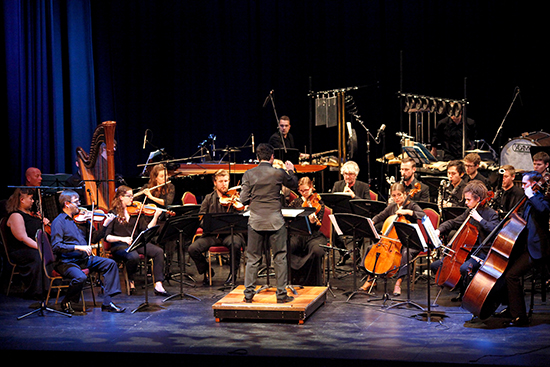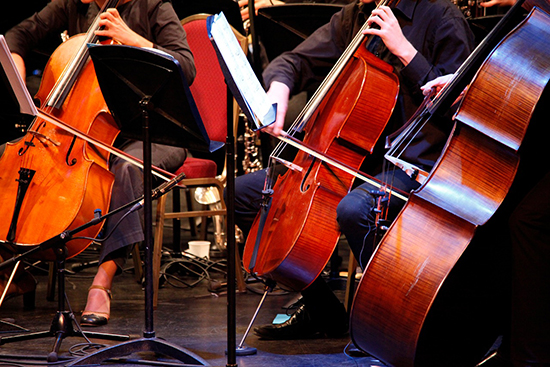On the precipice
Bec Scully: ELISION/ANAM, Enno Poppe, Speicher

ELISION Ensemble and students from ANAM, Speicher, BIFEM 2016
Enno Poppe’s Speicher is a play on memory, a greatly expanding field of knowledge for our generation. We know our memories are malleable, largely illusory, constantly mutating, decaying or enriching. In German, the term ‘speicher,’ meaning ‘storage,’ refers both to psychological memory storage, and also more specifically to a store of pitch class sets used in a compositional process.
At the opening of the piece there is no memory, only attention. Poppe’s atom of musical thought is the salty sul pont viola paired with bleak sonar-radio emissions from the accordion. These bare elements return recognisable, yet in eloquent settings and manipulated through unexpected readings. Vibrato is Poppe’s justification for challenging our traditional concept of a note as belonging to a fixed pitch. With intervals-wide, pitch-traversing vibrato we learn to reconsider our idea of a musical atom. We’re reminded of the pitch continuum at play in vibrato and reassess our assumption in our perception of the discrete tone.
By contrast, after these hypervibrato and ‘hyperchromatic’ divisions of less than a semitone, late Romantic string vibrato is introduced only for a moment and suddenly we can hear this normally ubiquitous left-hand string technique as a chaotic, over-stimulating, maelstrom of thousands of incomprehensible musical events. And in these small moments we might experience an appreciation of sound units on a small order of magnitude and perhaps experience the reverse operation of Schenkerian analysis which looks for the skeleton of a work, not for its biochemistry.
Conducted by Carl Rosman and performed by the champion forces of ELISION ensemble joined by the fresh blood of Australian National Academy of Music, the combined ensemble convincingly evoked cohesive textural moments and colouristic effects. The students clearly delighted in their full citizenship in any register of their instruments.

Speicher, BIFEM 2016
Shout-out to a grand-effort Parker-esque solo on alto sax by clarinettist Luke Carbon. Kyla Matsuura-Miller tag-teamed the second violin part at the 4th movement and knocked it out of the park with rhythmic finesse and delicious tonal ferocity. Props to Eli Vincent in valiantly helming the nucleus of the work as first viola. Applause to the professionals: concertmaster Graeme Jennings who was a consistent and efficient leader, cellist Séverine Ballon, whose early attack on the cello was the first and true expression of musical violence in the work; her solo in section one explores the highest pitches of the deepest strings, creating an innocent, swallowed sob in melody that was reminiscent of the frailty of a child’s voice. Tristram Williams, a strong advocate of this work, played with precision and expression. There were seriously stunningly executed harp treats in the texture from Marshall McGuire. Best and Fairest goes to James Crabb on accordion. The evolution from harmonics to accordion hums was sublime. Crabb, master of camouflage, introduced a foreign species of instrument to the full palette of orchestral instruments. It returned to the fore of the work’s texture, evoking a unique voice: an imperceptible transformation before our ears, as if Escher himself could draw sound. Like Escher, Poppe is a numerologist and does not believe the 12-tone technique would have been so successful were it not for the cultural significance of the number 12. This piece appears to be based around the number six on multiple levels. Six movements, each containing six parts, the hyper chromatic use of 6th tones.
Stylistically, most of this work is in Poppe’s own compositional language of clear texture and microtonal organic development. However, in a potential nod to John Adams’ The Chairman Dances, Poppe enters the stylistic world of the foxtrot challenging some students struggled to find their groove. Some bebop stomps were finely executed on the drum kit and one wished for similar conviction in the strings. From the ironic use of grotesquely pretty Hollywood strings to tone-dense Mondrian-esque geometric forces in the winds and Debussy’s harmonic gravity-defying language, textural transitions were the most spectacular feature of the ensemble’s interpretation.
A humble woodblock knock, emerging meekly from an apocalyptic orchestral force, elicited a chuckle from the audience, and true, a musical ugly-duckling it was. Our duckling returns as a pluck in the harp and we delight in its glorious transformation into a swan-tone adorned in overtones. Outside of this piece I would have serious doubts as to whether a single harp note held sufficient aesthetic power.
All these micro-details are essentially developmental links in an 80-minute epic, expansive enough to puff its chest at Beethoven’s 9th. In fact, at the close of Speicher it’s possible to hear the initial notes of that work’s recitative, a melody symbolic of refusal of new material. One can’t help but feel Poppe reached the precipice of a musical mind verging on new material, only to reiterate and reaffirm the work’s fidelity to singular ideas and their possibilities. Thus the piece exits before new material can be spoken, suspended on the trumpeter’s tongue.
–
Bendigo International Festival of Exploratory Music 2016: ELISION/ANAM, Speicher composer Enno Poppe, conductor Carl Rosman; Capital Theatre, Bendigo, 2 Sept
RealTime issue #134 Aug-Sept 2016






